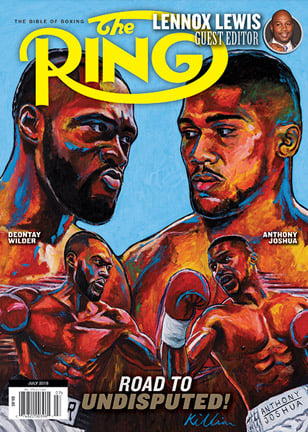The Travelin’ Man returns to Oxon Hill, Maryland – Part two
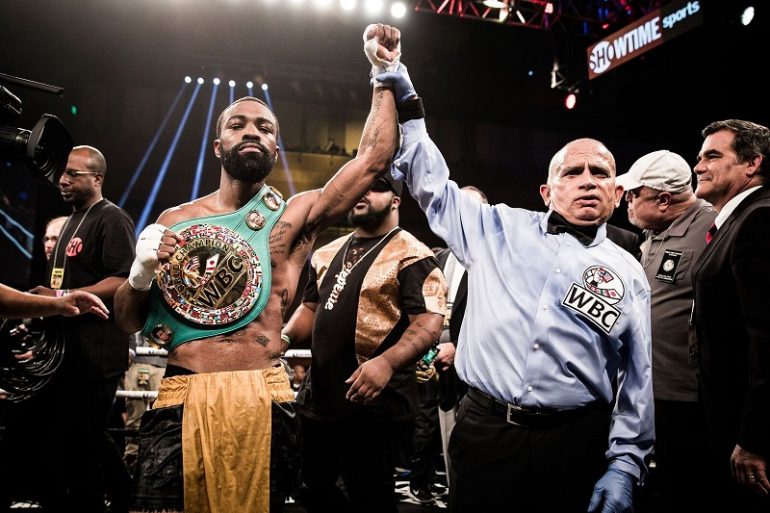
Please click here for Part One.
Saturday, May 19 (continued): I have yet to watch Gary Russell Jr.’s unanimous decision victory over Joseph Diaz Jr. or Adonis Stevenson’s title-retaining draw versus Badou Jack as a fan but, as the punch-counter who tracked Russell and Stevenson, it was a pleasure and a privilege.
Even while concentrating on his assigned fighter’s actions, a punch-counter can sense when a terrific fight is taking place, and those instincts are usually confirmed by the numbers seen between rounds. Speaking only for myself, I enjoy counting fighters who throw and land tons of punches because high-octane action sharpens my focus even more and makes the time fly by. I also love the challenge of tabulating prolific output in the sequence in which it is thrown, a task that is made much easier by years of experience.
Those years came in handy in compiling Russell’s data against Diaz, for he established new personal bests for punches thrown in a fight (992), attempted jabs (587) and attempted power punches (405). That high activity helped offset Diaz’s exceptional accuracy gaps (39%-20% overall, 32%-10% jabs, 42%-34% power) that enabled him to inflict significant statistical damage. Diaz landed only seven fewer total punches than Russell (199-192) and, while Russell prevailed 61-41 in landed jabs, Diaz connected with more power punches (151-138).
The closeness of the raw numbers suggests that Dave Braslow’s 115-113 score in Russell’s favor was closest to the mark. However an examination of the round-by-round breakdowns reveal the 117-111 scores submitted by Dave Moretti and Nathan Palmer were also justified because Russell prevailed nine rounds to three, in terms of total connects, 6-2-4 in landed jabs and 8-4 in power connects. Also, Russell averaged 82.7 punches per round to Diaz’s 40.9, was far busier in terms of jabs (48.9 attempts/5.1 connects per round to Diaz’s 10.7/3.4) and went shot-for-shot, in terms of power punches (33.8 attempts/11.5 connects per round to Diaz’s 30.3/12.6). While Russell enjoyed home ring advantage, I don’t believe it played a major role in the scoring.
Several other statistical nuggets were unearthed by CompuBox, Inc. in the Russell-Diaz aftermath:
* Diaz averaged 12.6 power connects per round, significantly more than the 7.8 achieved by Russell’s five previous opponents.
* Russell averaged 48.9 jab attempts per round, more than twice the 23.1 featherweight norm.
* Diaz’s 192 total connects are the most ever landed by a Russell opponent tracked by CompuBox, topping the 183 landed by Vasyl Lomachenko.
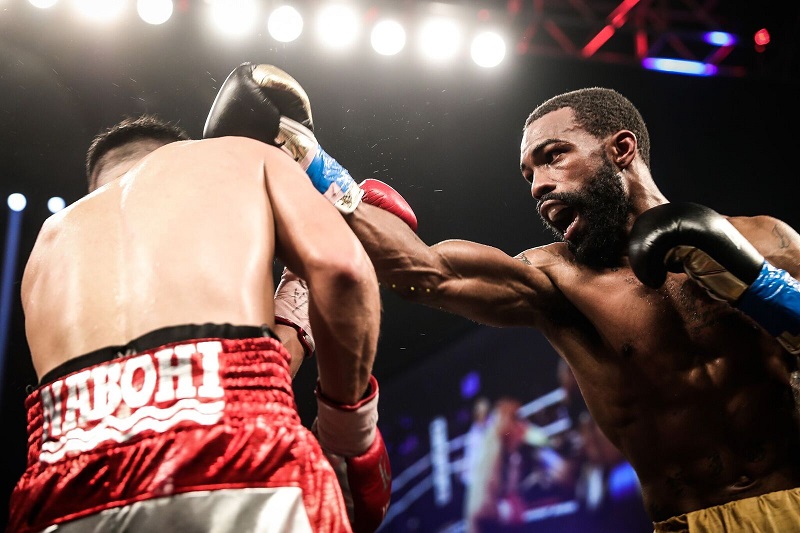
WBC featherweight titlist Gary Russell Jr. (right) vs. Joseph Diaz Jr. Photo credit: Amanda Westcott/Showtime
In the end, Russell’s volume won out over Diaz’s accuracy and superb body attack, which accounted for 88 of his 192 total connects (45.8%) and 86 of his 151 landed power punches (57%), both figures well above the 22.4% CompuBox average. For the record, body shots comprised 25.6% of Russell’s total connects (51 of 199) and 22.5% of his landed power shots (31 of 138).
Even more amazingly, Russell achieved his incredible output, despite a hand injury he said occurred early in the bout.
“I hurt my right hand in the second or third round, so we had to make the adjustments,” Russell told THE RING’s Joe Santoliquito. “(Diaz) couldn’t get past my jab. When he got close, we made sure to smother him. Then we reset and got back on the stick. We train to survive those body shots. We put the work in every day in the ring. We consistently grind and push ourselves to be great. We push ourselves to the limit.”
Despite the pain in his right hand, Russell credited his southpaw jab for the victory.
“The jab definitely dictated everything I did,” he said. “My speed offset everything he tried to do coming forward.”
The word around ringside was that Diaz didn’t throw enough punches to offset Russell’s industriousness, and the fighter said as much after the bout.
“I started attacking him too late,” Diaz admitted. “I didn’t pick it up until the eighth or ninth round. Gary Russell Jr. is a tremendous fighter and he did a great job keeping me at bay. I needed to start in the sixth round. He was throwing a lot of pitter-patter jabs to keep me at bay. He was trying to keep me guessing and make sure I had to think about coming in. Overall it was a good learning experience and I’ll definitely be back.”
One trend that didn’t hold was Diaz’s vaunted second-half surge, which was so prominent in his drive toward the Russell fight. While Diaz produced strong finishing kicks in nine previous CompuBox-tracked fights, Russell’s volume successfully negated Diaz’s blueprint. In rounds seven through 11, Russell out-landed Diaz 93-64 overall and 61-44 power before Diaz woke up in round 12 to lead 28-15 overall and 24-12 power. By then, it was too little and too late.
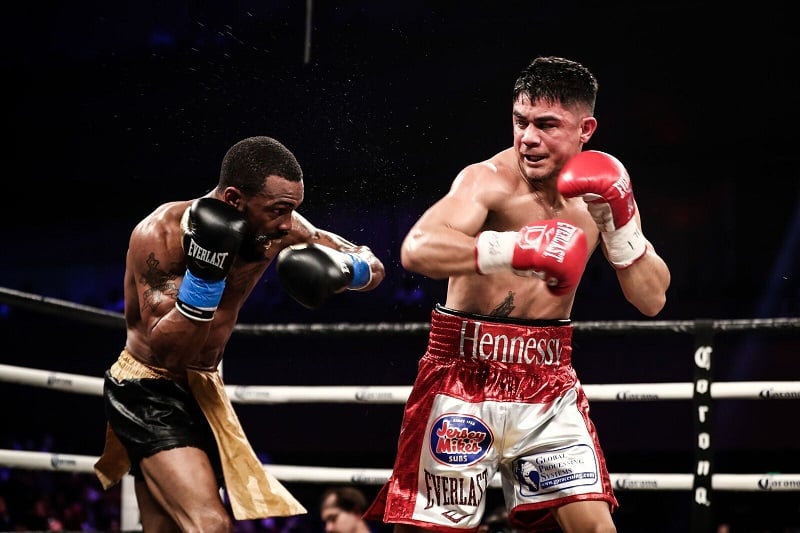
Photo credit: Amanda Westcott/Showtime
Diaz hoped his performance would earn the respect of fight fans. As for this one, “JoJo” had my respect long before climbing into the ring against Russell but his poise and persistence in the face of substantial resistance from a pound-for-pound talent confirmed he can compete well at a high level, on an elevated stage. If Russell does move up in weight and challenges for another title, especially if he does so in the next 18 months, Diaz should definitely be in the running to fill the vacancy. And if he rises to that occasion like he did this one – and if he throttles up, starting in round seven like he usually does – he could well join the ever-lengthening roll call of champions.
*
Most of the time, when one fighter lands considerably more punches than his opponent but doesn’t get the “W,” one has good cause to question the official outcome. And most times, observers are right to object, especially when the verdict is a draw in the champion’s adopted home country. For example, many thought Martin Murray should have dethroned then-WBA middleweight titlist Felix Sturm in Germany, five-and-a-half years ago, after the Brit out-threw and out-landed the house fighter by considerable margins (1,061-631 in attempts; 258-182 overall and 184-90 power in connects), but Sturm exited the ring with his belt still in tow. Although the result was hotly debated, the outrage wasn’t sufficient enough to spawn a rematch.
Conversely the draw between longtime WBC light heavyweight king Adonis Stevenson and Badou Jack in Toronto was well-received, not only as a fight but also as a verdict. If one only saw the final stats, one would have expected howls of protest, as Jack forged connect leads of 209-165 overall, 55-21 jabs and 154-144 power and percentage gaps of 38%-27% overall, 27%-8% jabs and 45%-40% power. But after ring announcer Christian Gauthier rendered the verdict, there was an air of acceptance – as well as hopes for a rematch.
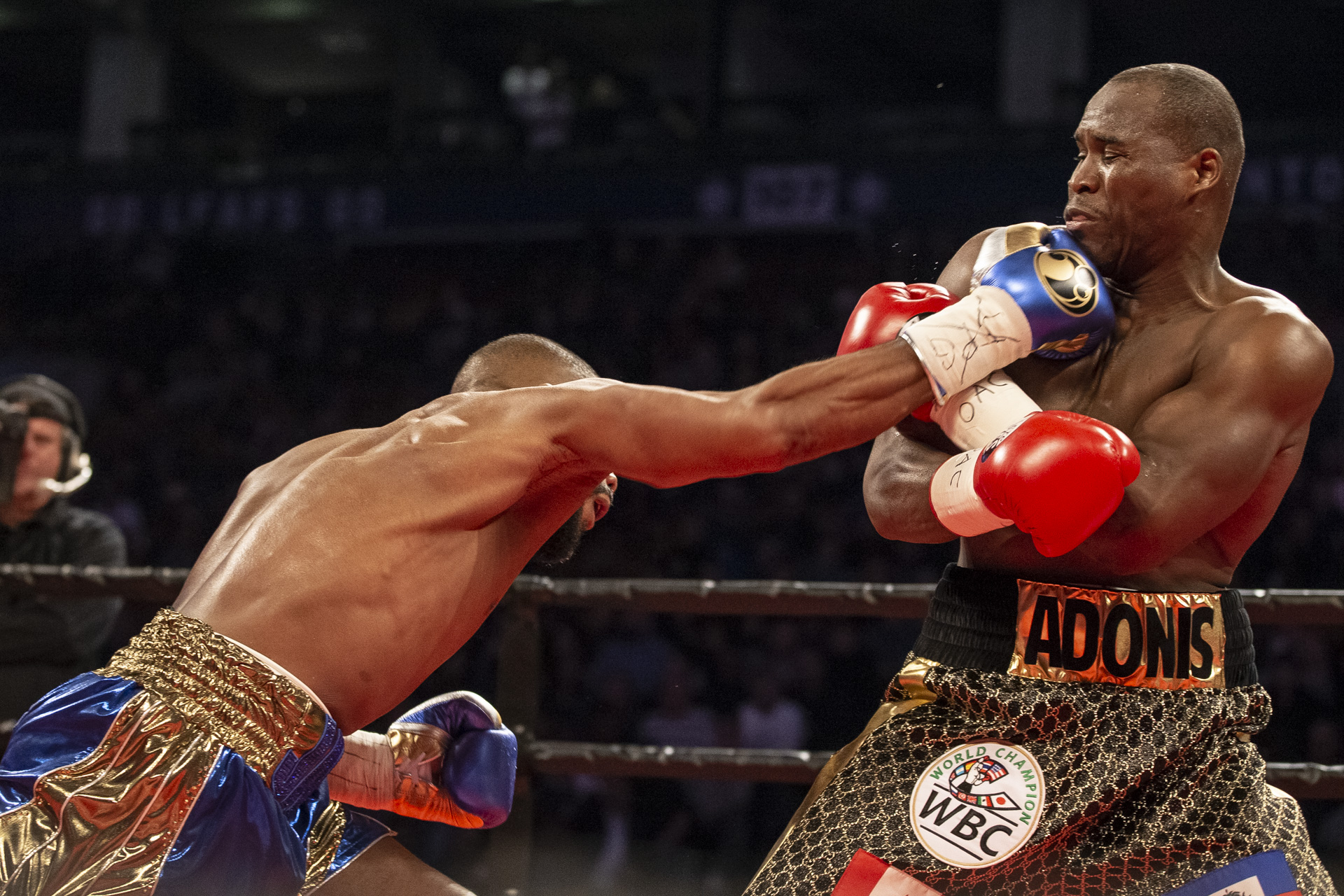
Badou Jack (left) takes it to WBC light heavyweight titlist Adonis Stevenson in the entertaining second half of their title bout. Photo by Esther Lin/Showtime
A deeper look into the numbers provides two possible answers as to why many felt a draw was an acceptable outcome. First, the round-by-round breakdown reveals that Jack out-landed Stevenson by just 6-5-1 in total connects, with Stevenson gaining a 4-1-1 lead in the first six rounds and Jack prevailing in five of the final six rounds. Second, Jack won his rounds by far bigger margins than Stevenson did. In the five rounds in which Stevenson prevailed, he out-landed Jack 95-57 overall and 88-40 power, while, in the six rounds Jack won, he bested “Superman” by 148-66 overall and 111-54 power. Not only that, Jack hurt Stevenson more severely during his surges, a surprising turn, given the champion’s lethal power and the challenger’s seemingly modest shot-for-shot pop. Therefore the final numbers were skewed in Jack’s favor but the round-by-round breakdowns mirrored the flow of the fight.
Showtime scorer Steve Farhood scored the fight 114-114, as did THE RING’s Mike Coppinger and the person conducting the live scoring for BoxingScene.com, all of whom agreed with the scoring of Guido Cavallieri and Eric Marlinski). Jesse Reyes’ 115-113 score for Jack is also within reason.
Stevenson said his robust body attack was a key factor in his performance and the numbers bore him out: 55.2% of his total connects (91 of 165) and 60.4% of his landed power shots (87 of 144) were body shots. Jack, renowned for his body work, also hit the flanks hard, as body shots accounted for 27.3% of his total connects (57 of 209) and 34.4% of his landed power punches (53 of 154).
“I went to the body and saw that he was fatigued,” Stevenson said. “I had to keep the pressure on him. He’s a slick fighter, a two-time world champion, but I felt I won the fight.”

Esther Lin/Showtime
Jack felt he won as well but, like Diaz, his second-half surge was part of the blueprint.
“It was a draw; of course I regret it,” he said, “but it was the game plan. I knew he was going to get tired. And I’m never tired. After three or four rounds, he didn’t really hit me. He didn’t really do nothing. I knew I was going to break him down but he’s a tough guy. He can take a punch but I thought I won the fight.”
Although Stevenson walked out of the ring with his WBC title intact, it was clear that, for the first time in his stop-and-start reign, the 40-year-old was weighed down by ring rust and advancing age. Although he hurt Jack several times, his blows, as a whole, lacked the speed and snap of previous years. Before now, Stevenson appeared invulnerable to Father Time but now one must begin factoring his age into future prognostications. Only an immediate rematch with Jack can properly determine the state of Stevenson’s game, and, hopefully “immediately” means “before the end of this year.”
In my pre-fight analysis of Stevenson-Jack I predicted Jack would win on points, and he came within a point of doing just that. Should they meet again, I believe “The Ripper” will take that final step and seize the crown, and he will do so in more emphatic fashion.
*
To my surprise – and consternation – I discovered that the staff inside the local arena shut off our internet access at ringside right after the end of the Russell-Diaz fight. Therefore I had to improvise if I wanted to email the final stats to the ringside press, the Showtime public relations team, CompuBox president Bob Canobbio and myself. My solution: I took a cell phone picture of the action screen bearing the final numbers, tapped out a brief summary, as well as all of the email addresses, and sent it out, thanks to whatever wireless system was present inside the arena. Less than five minutes later, I saw Sports Communications Manager Flo Jocou looking over my screen shot, and, once I confirmed with everyone that they had what they needed, I began to shut down and pack up.
Andy and I took a cab to the crew hotel, and, after saying our goodbyes, I returned to the room and began the final part of my work day: Inputting the stats from the five fights we counted into the master database, a process that took more than an hour. Meanwhile my room service meal (a grilled chicken sandwich and kettle chips) arrived, and, by the time I turned out the lights, it was 3:15 a.m. In all, it was a long but ultimately successful day.
Sunday, May 20: With the responsibilities of fight night behind me, I awakened after nearly five hours of unusually sound slumber, and, once I finished the daily routines, I spent the next hour catching up on my writing.
Once that was done, I packed my belongings, checked out of my room, walked outside and scanned for a taxi. One was parked about 100 feet away and, as I neared it, it became clear it was available.
After I informed the cabbie that I wished to go to Reagan National Airport, he asked a curious question: “Do you want to go the fast way or the slow way?” Of course, I said “the fast way.”
He wasn’t kidding; the normally 45-minute drive was completed in less than 30, thanks to light Sunday morning traffic and the route he chose, which seemed different than those I remembered. He made such good time that, once I entered the terminal, I thought I might be able to board a flight leaving earlier than my 1:15 p.m. bird to Pittsburgh. Unfortunately there were no other flights listed, so I steeled myself for a lengthy but hopefully productive stay.
My mobile boarding pass worked perfectly and I cleared security without a hitch. (Thanks, TSA Pre-Check.) The one flaw with the mobile passes is that the squiggles bore no information as to my seat number, so, to fix that, I had a gate agent print a physical copy for me.
My stay was indeed productive, as I finished writing Part One and got a good jump on Part Two. In between, I chatted with several seatmates, including one from my native West Virginia. Delby, a veteran attorney, not only has an unusual first name but she also comes from a town bearing an even neater name than that of my hometown – Goodhope. For the record, Goodhope is an unincorporated town located about two-and-a-half miles southwest of West Milford and 15 miles from Clarksburg. Following our talk – one whose subjects included the soon-to-be-released “Muhammad Ali: By the Numbers” – I offered (and she accepted) to give and autograph one of the dozens of promotional postcards I carry with me. I hope to be doing more of that in the coming weeks, for reasons that soon will be made clear.
The flight was uneventful, as was the two-and-a-half hour drive home that ended at 5:10 p.m., five minutes before my predicted arrival. After unpacking, I conducted a count on the Warrington-Selby fight that revealed the Leeds native out-landed the Welsh titleholder 244-176, in terms of overall connects. The most surprising stat was Warrington’s ability to out-jab the longer and jab-oriented Selby; he not only landed more of them (59-16), he also connected at a far higher percentage (26%-4%). That, in essence, is why CompuBox separates jabs from everything else; more often than not, the effectiveness of a fighter’s jab can have a profound effect on how the rest of his offense works, especially those like Selby, who depend so heavily on it.
Although I will be spending the next several weeks inside the Home Office, I certainly won’t be idle – and that’s a great thing. My goal going forward is to get far enough ahead in my research, so that I can fully concentrate on this Travelin’ Man’s next great adventure: My 26th consecutive trip to the International Boxing Hall of Fame’s Induction Weekend.
Until then, happy trails!
*
Lee Groves is a boxing writer and historian based in Friendly, West Virginia. He is a full member of the BWAA, from which he has won 16 writing awards, including two first-place awards since 2011. He has been an elector for the International Boxing Hall of Fame since 2001 and is also a writer, researcher and punch-counter for CompuBox, Inc. He is the author of Tales from the Vault: A Celebration of 100 Boxing Closet Classics (available on Amazon) and the co-author of the upcoming book Muhammad Ali: By the Numbers. To contact Groves, use the e-mail [email protected].
Struggling to locate a copy of THE RING Magazine? Try here or
Subscribe
You can order the current issue, which is on newsstands, or back issues from our subscribe page.


